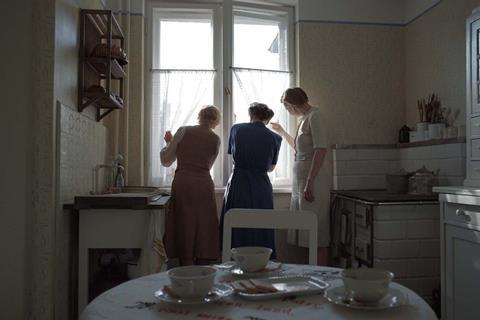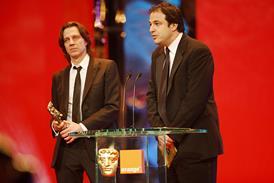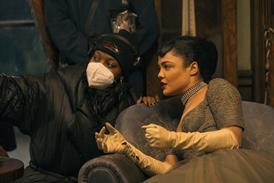Sound plays a crucial role in The Zone Of Interest — a film in which the Holocaust is heard but not seen. Sound designer Johnnie Burn and production sound mixer Tarn Willers talk about their imaginative, detail-rich approach.

Sound designer Johnnie Burn’s quest for authentic detail on Jonathan Glazer’s The Zone Of Interest took him not only to Auschwitz, where the film is set, but to more unexpected backdrops such as riots in modern-day Paris and an old firing range on the Isle of Wight.
Glazer is not the kind of filmmaker who would rely on a generic sound library, so when Burn needed to recreate the sound of gunshots in a concentration camp, he researched that guards in Poland would not have the same Second World War guns as soldiers on the frontline, they had to use old First World War weapons. He found the right guns, and took them to a “firing range on the Isle of Wight, with buildings that mimic the acoustic signature of Auschwitz”.
Then Burn recorded the gunfire using a microphone placed 150 metres away, mimicking the distance the execution block would have been from the protagonists’ house in the film. He knew how many gunshots per day would have occurred during the period the story takes place, and at what time they could be heard. “The project was done with as much historical accuracy as we could have, to show the utmost respect,” says Burn.
The Zone Of Interest looks at the Holocaust like no other film has done before — concentrating on the everyday lives of Auschwitz commandant Rudolf Höss and his wife Hedwig (played by Christian Friedel and Sandra Hüller) as they raise their children in a family house next to the camp.
Over the many years he envisioned the A24-backed film (loosely adapted from Martin Amis’s 2014 novel), writer/director Glazer made the crucial creative decision that he would only show the Höss family’s banal lives on their side of the wall. The film’s multi-layered sound design, however, would help the audience picture the atrocities they are unable to see on screen. Glazer says The Zone Of Interest is “two films — the one you see and the one you hear”.
Drawing conclusions

“He was clear that we would only ever hear the atrocities,” recalls Burn, whose credits include Glazer’s features Under The Skin and Birth as well as his commercials and music videos, and providing sound on further titles including Poor Things, Nope and Ammonite. “We are drawing upon the mental imagery and the knowledge that collectively is owned by the world to draw pictures in people’s head with sound.”
The project was planned in a unique way: production designer Chris Oddy was charged with building a replica of the Höss’s house on the outskirts of the Auschwitz site (very close to their real house, which had been modernised). Instead of having director of photography Lukasz Zal shoot the film in a traditional way, the team set up 10 cameras around the home, and scenes would unfold with cameras rolling simultaneously in different rooms.
Burn has received his first ever Oscar and Bafta nominations thanks to his work on The Zone Of Interest — nominated alongside production sound mixer Tarn Willers. The first time Willers met Glazer was on Zoom, and after a few pleasantries, the director laid down his very specific challenge. “He basically told me, ‘It’s going to be like Big Brother in a Nazi house. Those cameras are going to roll simultaneously. The actors are going to be free to improvise and move around and exist in this environment. There’s going to be no equipment in the shot. It’s not going to be the conventional filming method. How are you going to get the sound?’”
Willers, UK-born but living in Poland, was up for the challenge. “It quickly became apparent we couldn’t have boom mics with our actors, so we’d have to mic-up the space, this whole environment of the house and the garden. From the get-go, Johnnie and I were in conversation regularly.” And because Willers was still shooting another job while The Zone Of Interest was in prep, Burn and his team could start testing different mics and set-ups.
“Jon [Glazer] was insistent on having perspective sound for each of the 10 cameras,” Willers adds, and in addition to that they found static positions for 40 more directional microphones (not all operational at once) throughout the house and garden.
A period-accurate telegraph pole in the garden helped disguise cables being fed into the attic of the house. A few unavoidably visible mics or wires could be fixed during the visual-effects process. Those static mic tracks were augmented by every actor having a radio mic.
Given his focus on authenticity, Glazer did not want any ADR (additional dialogue recording) to be used, nor did he expect pristine dialogue. “Normally my work is to go in and get dialogue and eradicate all the other sounds,” Willers explains. “On this job, the dialogue wasn’t necessarily central at times — it was the chit‑chat of everyday in a house.”
Burn also knew the ambient sounds of the home would be crucial. “It was significant that the house was a real build, that it was a real stone floor, not made of rubber to be quiet,” he says. “We had that stone floor, and those thick walls, so that the house sounded like it should.” Willers also recorded the sounds of birds and frogs on the site.
Throughout the shoot, 10 cameras collectively recorded 800 hours of footage, with 20 audio tracks. For every shot in the film, Burn and Glazer would listen to the 20 tracks of recorded audio. “Jon is meticulous in that way. He wanted to hear all of it,” says Burn, noting this part of the process took about 18 months.
Burn calls the shoot “film one” — the family drama that was shot in Poland and edited and had its own sound mix. Then it was time for “film two” — also years in the making — to come into the process.
Burn brought in the “over the wall” sounds that he had been working on for more than two years, to see how Glazer and editor Paul Watts wanted to add them into the family drama’s soundscape — and that took another seven months to layer. Finally, Mica Levi’s score would be added — Glazer having decided that it functioned better as an overture and end piece rather than the original plan of having 40 minutes of score layered in the first part of the film.
Just as Glazer conducted years of research before writing the script, Burn was likewise involved years before shooting — he set out on his own research journey, rereading key texts such as books by Holocaust survivor Primo Levi, and scouring through testimonies from the Auschwitz-Birkenau Museum and Memorial. Burn composed some 600 pages of his own notes on how Auschwitz might have sounded.
“That job was actually less about working on a film and more about becoming an expert on the sound of Auschwitz,” he recalls. Burn studied details about the roll-call bells, how prisoners had described the hum of the electric fences, what times the trucks and trains arrived each day. “It had to sound industrial, in order for it to accurately and respectfully represent what happened there. It’s probably more comprehensive than we had imagined at first.”
Some of The Zone Of Interest’s soundscape came from unexpected places, at Glazer’s request. “Jon was clear, ‘I don’t want you to get a bunch of actors in a voice booth and tell them, pretend this is happening to you.’ He wanted us to find things in the real world that sounded authentic and try to repurpose them.”
For instance, back in 2022 there was a workers strike in Paris. Burn and his team jumped on the Eurostar, anticipating they would record “young men shouting aggressively in French” with a more-authentic texture than could be achieved in a London recording studio. It evoked more accurately what French prisoners in the camp would have sounded like.
Burn uncovered hundreds of chilling details, such as how Auschwitz guards would rev their motorbikes loudly outside the gas chambers, so that victims’ screams could not be heard as clearly. Now those bikes are part of the sound mix the audience hears from the Höss’s garden without knowing why.
For Burn, it was important the horrors were not exaggerated in the final sound mix — gunshots needed to sound muted depending on their distance from the family house, for instance. “Banality is a key thing. We didn’t want to sensationalise it.”























No comments yet